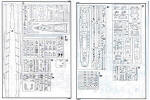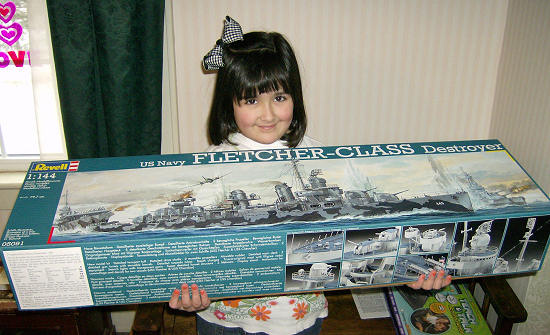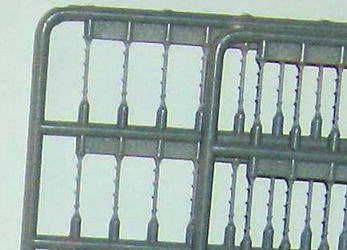Revell 1/144 Fletcher Class Destroyer
|
KIT #: |
05091 |
|
PRICE: |
$ |
|
DECALS: |
Yes |
|
REVIEWER: |
Len
Roberto |
|
NOTES: |
|
Class overview:
Name:
Fletcher class destroyer
General characteristics
Type:
Destroyer
Displacement:
2,050 tons (standard);
2,500 tons (full load)
Length:
376.5 ft (114.8 m)
Beam:
39.5 ft (12.0 m)
Draft:
12.5 ft (3.8 m)
Propulsion:
4 Babcock & Wilcox oil fired
boilers; 2 General Electric geared steam turbines; 2 screws; =60,000shp
Speed:
36.5 knots (67.6 km/h)
Range:
5,500 miles at 15 knots
(8,850 km at 28 km/h) [1]
Complement:
329 officers and men
Armament:
• 5 × 5 in (127 mm) guns,
• 6–10 × 40 mm AA guns (early ships carried 4 × 1.1 in guns),
• 7–10 × 20 mm AA guns,
• 10 × 21" (533 mm) torpedo tubes (2×5),
• 6 × K-guns,
• 2 × depth charge racks
The United States Navy commissioned 175
Fletcher-class destroyers between 1942 and 1944. They were built by
shipyards across the
United States
for service in World War II, and some served during the Korean War and into
the Vietnam War. Ironically, many were sold to the very countries they had
fought against: Italy, Germany, and Japan,
as well as other navies, where they would go on to have even longer,
distinguished careers. Several others were cancelled prior to being laid
down.
The Fletcher class=2 0(named for Admiral Frank F. Fletcher) was the
largest class of destroyer ordered, and was also one of the most successful
and popular with the destroyer men themselves. Compared to earlier classes
built for the Navy, they carried a significant increase in anti-aircraft
(AA) weapons and other weaponry, which caused displacements to rise. Their
flush deck construction added structural strength, although it did make them
rather cramped.
Throughout the course of World War II, the
number of AA weaponry increased resulting in five twin-40 mm Bofors plus
seven 20 mm weapons by 1945. Fifty-one were further modified beginning in
1945, replacing the forward torpedo tubes and midships 40 mm twin Bofors
with quad mounts for a total of 14 barrels, and the seven 20 mm singles with
six 20 mm twins. Three (Pringle, Stevens, Halford) were built (six planned)
with aircraft catapults, resulting in the deletion of one 5-inch mount and
the after set of torpedo tubes. This alteration was not a success in service
and was not repeated. The three destroyers were later converted to the
normal Fletcher-class configuration.
Nineteen were lost during World
War II; six more were damaged and not repaired. Postwar, the remainder were
decommissioned and put into reserve.
With the outbreak of the Korean War many were returned to active
duty. During this time 39 were refitted, reducing their overall main
armament and the number of torpedo tubes. A new ahead-throwing weapon called
Weapon Alpha was installed in many of the ships. Others carried trainable
hedgehogs. (Which is good as untrainable hedgehogs can leave a mess on
the decks. Ed)
 Features:
movable rudder, props, and gun
barrels, clear searchlight lenses, display stand, decals for black waterline
boot stripe, rigging line supplied for railing.
Features:
movable rudder, props, and gun
barrels, clear searchlight lenses, display stand, decals for black waterline
boot stripe, rigging line supplied for railing.
Decals
and instructions to cover 2 ships:
lead ship of the class DD-445 USS
Fletcher summer 1942 and DD-451 USS Chevalier fall 1942.
What I have read so far indicates
some work needs to be done to do USS Chevalier accurately.
This is a round bridge model so it
limits the options as to what ships you can get out of it.
As you can see with the help of my
lovely 5 year old daughter, this is a massive box.
Think of the box for the 1/72 scale
subs and you get the idea.
The hull is in 2 parts and
dry-fitting was easy and tight-
looks to be very well engineered.
The hull measures out at just under
32 inches.
There are 2 trees contain the
parts for the very nicely molded 5 inch guns and turrets.
Gun barrels are
 movable.
2 long parts are for the display
stand.
The deck actually slots into the
top parts of the stiffeners and will be hidden by the deck houses.
This should ensure proper alignment
and a solid structure for the model.
movable.
2 long parts are for the display
stand.
The deck actually slots into the
top parts of the stiffeners and will be hidden by the deck houses.
This should ensure proper alignment
and a solid structure for the model.
The model sports a movable
rudder and props.
There are 2 sprues of stanchions
around the decks that Revell provides black rigging thread for the railings.
I’m sure there are better modelers
than I that could make this work but to me-
I do not see how I can do a proper
job with so many individual plastic stanchions.
Rigging 2-3 lines around all of
these seems like a no-win situation.
They are not strong enough to take
the man-handling required to rig them all and look proper at the end.
Here is the only part of the kit
where I personally will hope for some photoetch brass to replace or if not, I
will perhaps replace the plastic and drill down through the deck and use brass
rod for more strength.
 A
very nicely detailed instruction booklet with 65 steps is provided.
A decent coil of black thread for
rigging the railing and the mast rigging.
One of the things I always find a
pain in the rear to get properly masked is solved in this kit.
The black waterline boot is
provided by 6 decal strips.
A very complete set of paper flags
is also in the kit.
A separate fold out sheet shows the
camo measures for the 2 choices.
I am pretty sure USS Fletcher also
wore the Navy blue scheme in 1943.
A
very nicely detailed instruction booklet with 65 steps is provided.
A decent coil of black thread for
rigging the railing and the mast rigging.
One of the things I always find a
pain in the rear to get properly masked is solved in this kit.
The black waterline boot is
provided by 6 decal strips.
A very complete set of paper flags
is also in the kit.
A separate fold out sheet shows the
camo measures for the 2 choices.
I am pretty sure USS Fletcher also
wore the Navy blue scheme in 1943.
This
is a mammoth kit that will offer tons of room for superdetailing.
It
is fabulously molded and as we say looks stunning in the box.
Shipped from the
UK by Hannants my
total cost was just over $100.
If this was a Trumpeter kit it
would be $300.00
How can Revell
Germany produce such a
massive and well done kit for such a great price?
Bravo Revell-
hope there is a square bridge
coming too!
I will let it rest a while
while gathering as much reference as I can on USS Fletcher, a ship with a pretty
interesting war record.
I will await what the aftermarket
companies come up with for this beauty of a kit.
If you would like your product reviewed fairly and quickly , please
contact
me or see other details in the
Note to
Contributors.
Back to the Main Page
Back to the Previews Index Page
 Features:
movable rudder, props, and gun
barrels, clear searchlight lenses, display stand, decals for black waterline
boot stripe, rigging line supplied for railing.
Features:
movable rudder, props, and gun
barrels, clear searchlight lenses, display stand, decals for black waterline
boot stripe, rigging line supplied for railing.
 Features:
movable rudder, props, and gun
barrels, clear searchlight lenses, display stand, decals for black waterline
boot stripe, rigging line supplied for railing.
Features:
movable rudder, props, and gun
barrels, clear searchlight lenses, display stand, decals for black waterline
boot stripe, rigging line supplied for railing.
 movable.
2 long parts are for the display
stand.
The deck actually slots into the
top parts of the stiffeners and will be hidden by the deck houses.
This should ensure proper alignment
and a solid structure for the model.
movable.
2 long parts are for the display
stand.
The deck actually slots into the
top parts of the stiffeners and will be hidden by the deck houses.
This should ensure proper alignment
and a solid structure for the model.